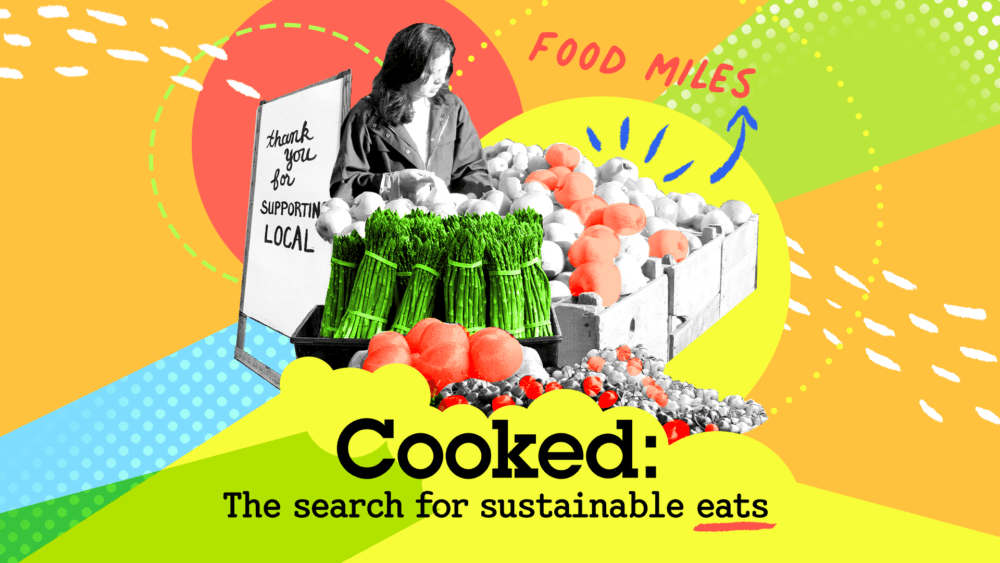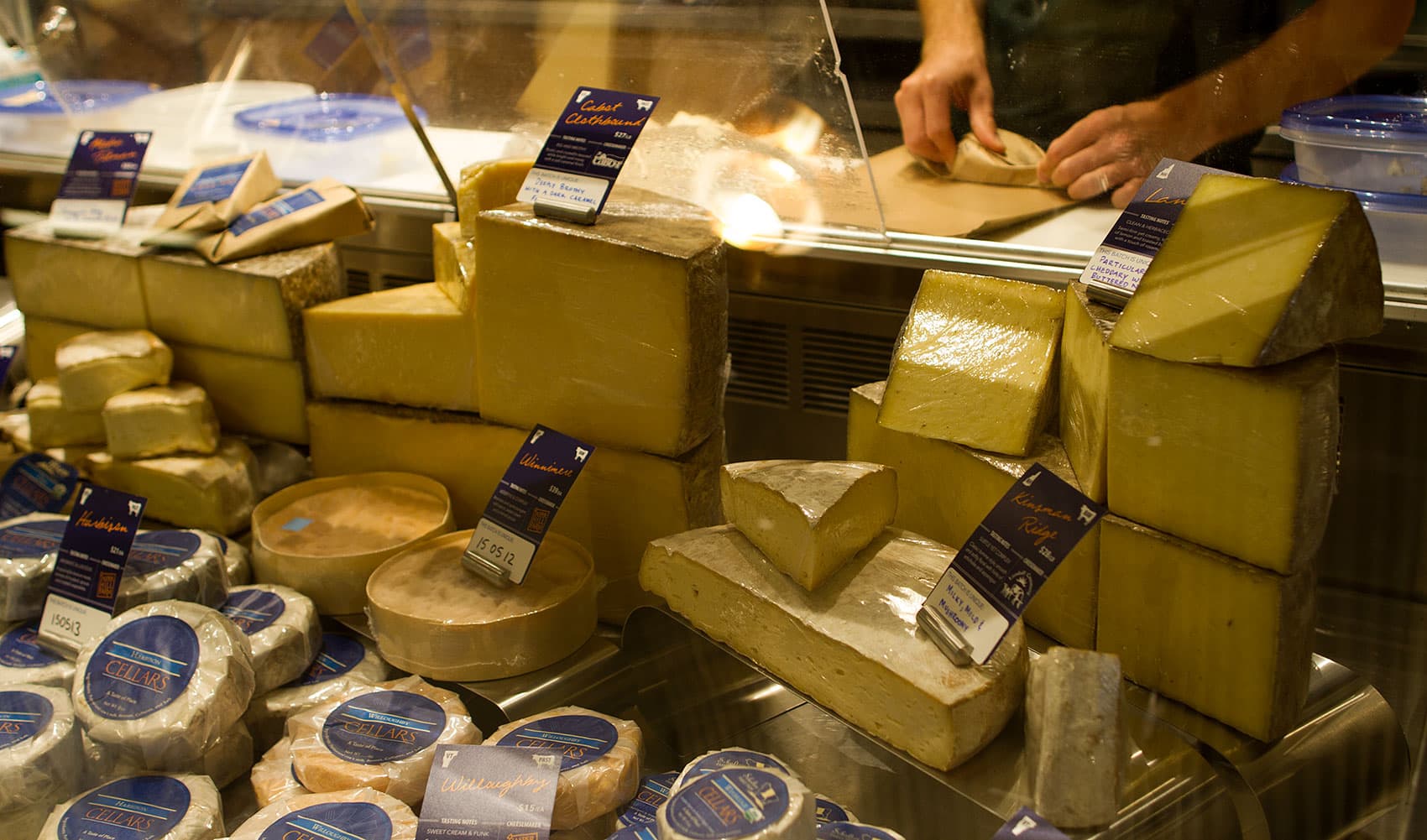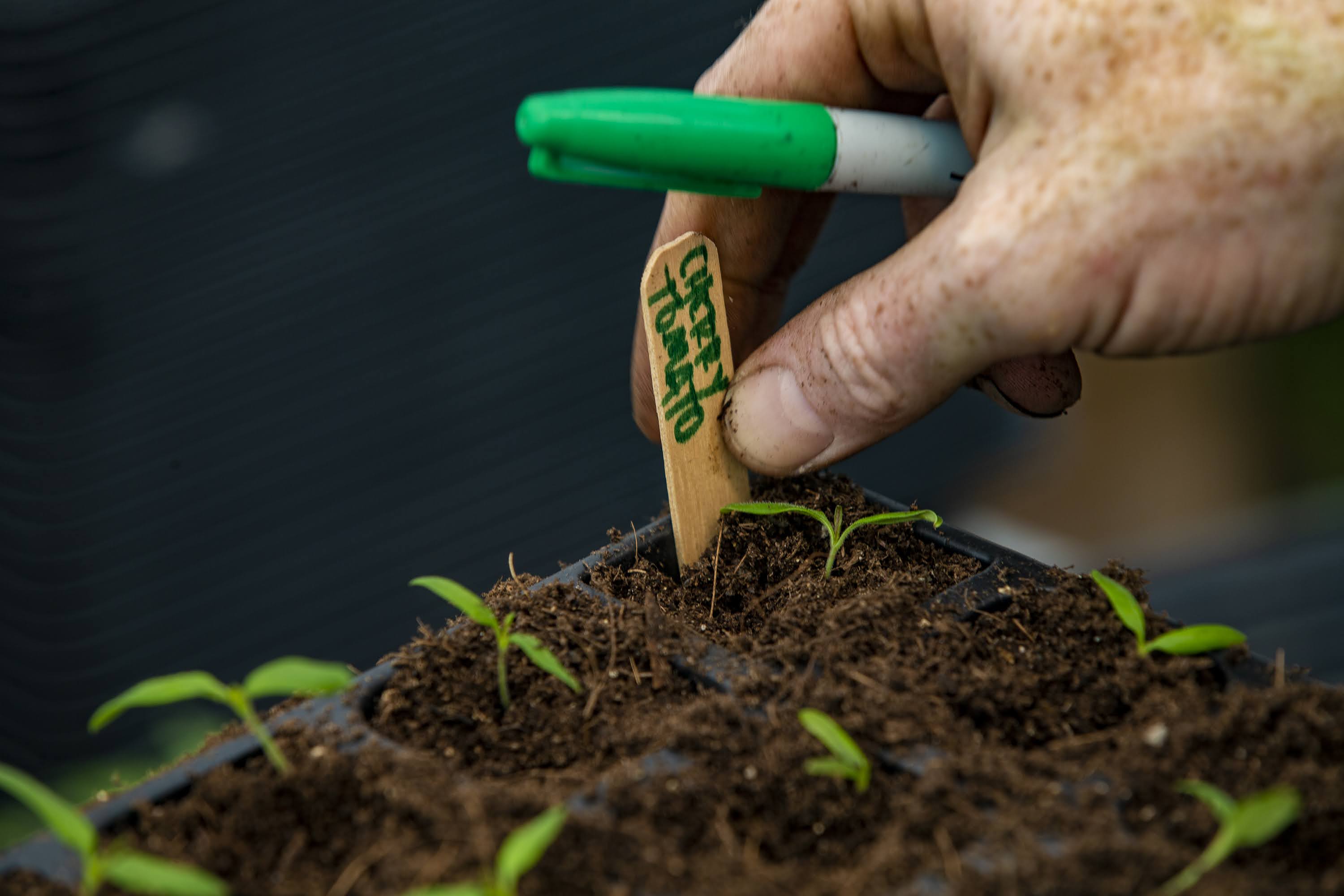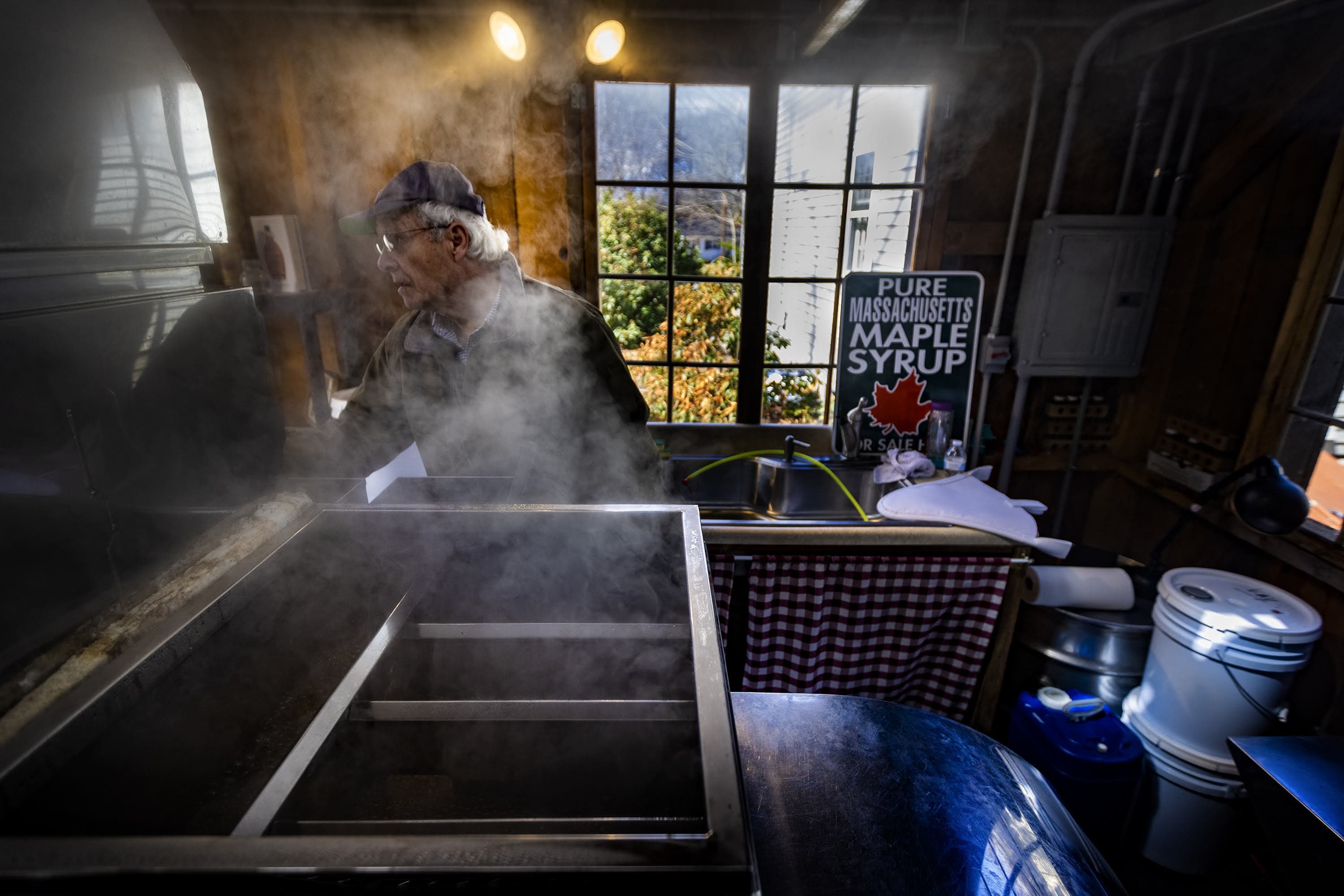Advertisement
Cooked: Does eating local really reduce your impact on climate change?

This is an excerpt from WBUR's Cooked newsletter. Sign up to understand how to reduce your impact on climate change and take actionable steps so YOU can make a difference.
It was a big day for Kannan Thiruvengadam. A flatbed truck was arriving with his farm’s first greenhouse, and he was bouncy with anticipation.
“This is so exciting!” said Thiruvengadam, who does actually speak in exclamation points. “It'll be a space for people to come together, have some food that's harvested right there!”
But the farm is in East Boston, and that morning he had a very Boston problem: two illegally-parked cars blocking the delivery route.
“This has nothing to do with the greenhouse!” he laughed. Then he reconsidered. “It’s an urban farm; this is an urban greenhouse and an urban problem.”

Eastie Farm is made up three plots of land — and one greenhouse — sandwiched between buildings and behind billboards around East Boston. The neighborhood has one of the highest immigrant populations in Boston and a median household income below the average. It’s also the Boston neighborhood with the farthest average distance to a grocery store.
Thiruvengadam's farm helped feed people in the pandemic and works with other local farms to supply 400 fresh produce bags to people living in public housing. But he acknowledged his tiny farm can only make a small dent in food insecurity. “We do not grow enough food to feed even a block of East Boston, probably,” he said.
But he’s got another mission: connecting people to their food. For him, there’s magic in a child pulling a carrot from the ground and realizing with a shock that vegetables grow in dirt.
“This is where you get connected to the Earth, and we need that connection back,” he said. Food “doesn’t come out of nowhere.”
Advertisement
This is the root of the problem, so to speak: most of us don’t know where our food comes from, so we don’t understand its effect on the climate. Local food can be part of the solution, but maybe not in the way you think.
So, where does food come from in New England, other than Eastie Farm? Let’s look at some numbers.
The Numbers Tell A Story
- New England agriculture peaked around 1910. By 1945 about 15% of the region — around 6 million acres — was still farmland.
- There are now just under 4 million acres of farmland in New England, and about 30,000 farms.
- Massachusetts ranks among the states with the highest risk of farmland loss in the country.
- New England farmers have just under 200,000 dairy cows. Vermont produces the most dairy in New England.
- We New Englanders kick butt in maple syrup, producing about half of the national supply. Maine produces more than 95% of the country’s wild blueberries.
- Despite this abundance of milk, maple syrup and wild blueberries, New England farms produce only about 10% of the food we eat in the region.
- The Natural Resources Defense Council estimates that most produce grown in the U.S. travels about 1,500 miles before it’s sold. This journey that cucumbers take from the farm to you is known as “food miles.”
Deep Dive: The Truth About Food Miles
Aha, you say — let’s cut down those food miles! And it makes sense: food trucked 30 miles has a smaller carbon footprint than food trucked 3,000. Turns out, however, food miles don’t matter as much as we thought. Transportation accounts for only about 11% of a food’s emissions in the U.S. (Fish is a little different, but we’ll cover that in the next email.)
One study suggested that occasionally swapping out red meat and dairy, even less than one day a week, makes a bigger dent in emissions than buying all your food locally.
“A lot of people have the idea that buying local food is the thing to do for climate, but it's actually not the case. The data don't bear that out,” said Tamar Haspel, a Washington Post food and science columnist, who details her Cape Cod food-growing experiences in the book “To Boldly Grow.” “Getting a food from far away where it can be grown efficiently almost always does have a lower climate impact than getting something from your local farmer.”
It’s also about “how does it travel,” said Tim Griffin, a professor of Nutrition, Agriculture and Sustainable Food Systems at Tufts. Tomatoes arriving by ship or train have a smaller carbon footprint per tomato than food that is flown in or the two tomatoes you picked up at that quaint farm after driving hours into the countryside.
This was not the message I wanted to hear, by the way. So, when Griffin first told me this, I basically threw a tantrum and demanded proof.
Well, those smart grad students at Tufts went out and did some sleuthing for us. Here’s what they found:
Local cheese versus far-away cheese

Whether your cheese comes from Vermont, Wisconsin or California, it still comes from burping cows. “Most of the impacts come from the production of milk,” said Tufts student Alexandra Stern. Food miles account for a small amount of emissions, “but for other impact categories like water or land, the fact that it's local doesn't really change much, especially if the practices for producing the cheese are very similar.”
Local tomatoes versus Florida tomatoes

In the summer, when stores are heaped with locally-grown tomatoes, buy them!
But in the middle of New England winter, nobody is growing tomatoes locally unless they’re hydroponic or in a greenhouse. While these practices can be environmentally sound, studies show that tomatoes grown in a Florida field had a lower environmental impact than greenhouse tomatoes from Ontario (sorta local) or hydroponic tomatoes from Maine.
“Trying to grow local can do more harm than good,” MIT research scientist Elodie Blanc wrote in an explainer. “If, for instance, producing locally entails growing tomatoes in greenhouses that need to be heated, then the environmental footprint will be much higher than growing them in a suitable region and transporting them, especially if they're transported by boat.”
Maple syrup and honey versus cane or beet sugar

Big win here for local sweeteners!
The research suggests honey and maple syrup have far lower environmental impacts than cane or beet sugar, even though it can take a lot of energy to turn 40 gallons of tree sap into 1 gallon of maple syrup.
Cultivating sugar beets and sugar cane leads to high emissions, soil erosion, heavy water use and diminished biodiversity. And honey and maple production offer large ecosystem benefits, like carbon stored in maple trees and bees pollinating vegetables.
Ah, the sweet taste of local victory!
Griffin made a good point, though: given the huge amount of refined sugar that Americans eat, there’s no way honey and maple syrup could scale up to meet demand.
THE BIG TAKEAWAY:
Food miles matter, but what matters much more is how the food was produced and how it got to you.
3 Reasons Buying Local Matters
So, should you stop buying local food? No way! Supporting New England farmers is important for lots of reasons. “You get this agricultural economy that’s local. You get to see where it comes from. You get to talk to the person who grew it. You get to bring a kid to see, you know, a pig or a carrot or an apple,” said Haspel. “And those things really matter.”
And, since we’re focusing on the environment, here are three reasons why buying local matters in a climate-changing world:
1. You think COVID-19 screwed up the supply chain? Wait ‘til you see what climate change can do.
Climate change is already disrupting American agriculture, like the devastating floods that hit farmers in Massachusetts and California in 2023. New England cannot grow enough food to feed everyone who lives here, but we can definitely grow more.
“This place that we call New England has a history of feeding people very well for thousands and thousands of years,” said Lisa Fernandes, former communication director for Food Solutions New England, which hopes that 50% of the region’s food will be produced locally by 2060.”
Growing more food closer to home will make the region more resilient to climate change, Fernandes said. That’ll help keep the shelves full “if things hit the fan.”
2. Diversified farms often adapt better to climate change.
Agriculture in New England is feeling the effects of climate change: maple sugar season is getting shorter and less predictable; fruit trees are suffering from erratic weather; Northeast farmers are feeling the effects of both drought and floods.
Desa Van Laarhoven, executive director of Round the Bend Farm in Dartmouth, Mass., said she’s seen a huge uptick in windstorm intensity over her decade-plus on the farm: “It’s completely different than it was in the beginning.”
New England, like the rest of the country, has big industrial farms that grow lots of food efficiently. But growing only one crop, like potatoes or apples, can leave farms vulnerable to climate disruptions like severe storms and invasive pests.
The region also has thriving, diversified farms, with a mix of crops and livestock. These can often adapt more quickly and experiment more easily with things like climate-resilient crops, agroforestry and “pollinator-friendly” solar.
At Round the Bend, for instance, garden manager Benoit Azagoh-Kouadio is using woody debris from wind-damaged trees to try Hügelkultur, a technique of growing crops on a bed of buried, rotting logs. “As that breaks down, it'll provide years and years of fertility for these beds,” he said. “It does pay off in the long run, in terms of creating an ecology that is really healthy and nutritious and abundant.”
Regenerative agriculture can also build soil that stores carbon. Scientists are still figuring out how exactly to measure carbon storage and loss in soil, but the idea of using our dirt wisely has gained traction as a possible climate solution. Healthy soil also supports biodiversity, from birds and bugs to blue toadflax.
3. Urban farms can mitigate extreme heat, flooding and other effects of climate change in cities.
In Boston, places like Eastie Farm, The Food Project and the Urban Farming Institute offer ecological advantages like cooling green space in urban heat islands, reduced air pollution and stormwater drainage.
Tristram Keefe, farm enterprise manager at the Urban Farming Institute, said urban farms can also serve as “entry points for people who are kind of alienated from the land.” Reconnecting city-dwellers with dirt, farming and food may be the first step toward a more sustainable food system.
This article was originally published on August 30, 2022.
